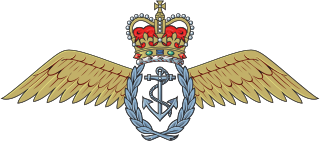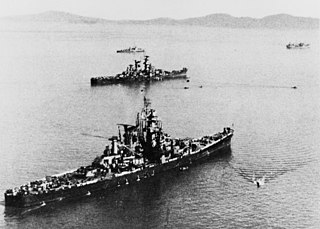Related Research Articles

The Fleet Air Arm (FAA) is one of the five fighting arms of the Royal Navy and is responsible for the delivery of naval air power both from land and at sea. The Fleet Air Arm operates the F-35 Lightning II for maritime strike, the AW159 Wildcat and AW101 Merlin for commando and anti-submarine warfare and the BAE Hawk as an aggressor.

USS Enterprise (CV-6) was a Yorktown-class carrier built for the United States Navy during the 1930s. She was the seventh U.S. Navy vessel of that name. Colloquially called "The Big E", she was the sixth aircraft carrier of the United States Navy. Launched in 1936, she was one of only three American carriers commissioned before World War II to survive the war. She participated in more major actions of the war against Japan than any other United States ship. These actions included the attack on Pearl Harbor — 18 Douglas SBD Dauntless dive bombers of her Air Group arrived over the harbor during the attack; seven were shot down with eight airmen killed and two wounded, making her the only American aircraft carrier with men at Pearl Harbor during the attack and the first to sustain casualties during the Pacific War — the Battle of Midway, the Battle of the Eastern Solomons, the Battle of the Santa Cruz Islands, various other air-sea engagements during the Guadalcanal Campaign, the Battle of the Philippine Sea, and the Battle of Leyte Gulf. Enterprise earned 20 battle stars, the most for any U.S. warship in World War II, and was the most decorated U.S. ship of World War II. She was also the first American ship to sink a full-sized enemy warship after the Pacific War had been declared when her aircraft sank the Japanese submarine I-70 on 10 December 1941. On three occasions during the war, the Japanese announced that she had been sunk in battle, inspiring her nickname "The Grey Ghost". By the end of the war, her planes and guns had downed 911 enemy planes, sunk 71 ships, and damaged or destroyed 192 more.

Task Force 11 is a designation that has been used by the United States armed forces for two separate units.
A task force (TF) is a unit or formation established to work on a single defined task or activity. Originally introduced by the United States Navy, the term has now caught on for general usage and is a standard part of NATO terminology. Many non-military organizations now create "task forces" or task groups for temporary activities that might have once been performed by ad hoc committees.

Task Force 16 (TF16) was one of the most storied task forces in the United States Navy, a major participant in a number of the most important battles of the Pacific War.

The United States Fleet Forces Command (USFF) is a service component command of the United States Navy that provides naval forces to a wide variety of U.S. forces. The naval resources may be allocated to Combatant Commanders such as United States Northern Command (USNORTHCOM) under the authority of the Secretary of Defense. Originally formed as United States Atlantic Fleet (USLANTFLT) in 1906, it has been an integral part of the defense of the United States of America since the early 20th century. In 2002, the Fleet comprised over 118,000 Navy and Marine Corps personnel serving on 186 ships and in 1,300 aircraft, with an area of responsibility ranging over most of the Atlantic Ocean from the North Pole to the South Pole, the Caribbean Sea, Gulf of Mexico, and the waters of the Pacific Ocean along the coasts of Central and South America.

USS Essex (CV/CVA/CVS-9) was an aircraft carrier and the lead ship of the 24-ship Essex class built for the United States Navy during World War II. She was the fourth US Navy ship to bear the name. Commissioned in December 1942, Essex participated in several campaigns in the Pacific Theater of Operations, earning the Presidential Unit Citation and 13 battle stars. Decommissioned shortly after the end of the war, she was modernized and recommissioned in the early 1950s as an attack carrier (CVA), eventually becoming an antisubmarine aircraft carrier (CVS). In her second career, she served mainly in the Atlantic, playing a role in the Cuban Missile Crisis. She also participated in the Korean War, earning four battle stars and the Navy Unit Commendation. She was the primary recovery carrier for the Apollo 7 space mission.

The Sixth Fleet is a numbered fleet of the United States Navy operating as part of United States Naval Forces Europe. The Sixth Fleet is headquartered at Naval Support Activity Naples, Italy. The officially stated mission of the Sixth Fleet in 2011 is that it "conducts the full range of Maritime Operations and Theater Security Cooperation missions, in concert with coalition, joint, interagency, and other parties, in order to advance security and stability in Europe and Africa." The current commander of the Sixth Fleet is Vice Admiral Eugene H. Black III.

The Fast Carrier Task Force, was the main striking force of the United States Navy in the Pacific War from January 1944 through the end of the war in August 1945. The task force was made up of several separate task groups, each typically built around three to four aircraft carriers and their supporting vessels. The support vessels were screening destroyers, cruisers, and the newly built fast battleships.

The Seventh Fleet is a numbered fleet of the United States Navy. It is headquartered at U.S. Fleet Activities Yokosuka, in Yokosuka, Kanagawa Prefecture, Japan. It is part of the United States Pacific Fleet. At present, it is the largest of the forward-deployed U.S. fleets, with 60 to 70 ships, 300 aircraft and 40,000 Navy, Marine Corps personnel, and Coast Guard support personnel. Its principal responsibilities are to provide joint command in natural disaster or military operations and operational command of all US naval forces in the region.

USS Wasp (CV/CVA/CVS-18) was one of 24 Essex-class aircraft carriers built during World War II for the United States Navy. The ship, the ninth US Navy ship to bear the name, was originally named Oriskany, but was renamed while under construction in honor of the previous Wasp (CV-7), which was sunk 15 September 1942. Wasp was commissioned in November 1943, and served in several campaigns in the Pacific Theater of Operations, earning eight battle stars. Like many of her sister ships, she was decommissioned shortly after the end of the war, but was modernized and recommissioned in the early 1950s as an attack carrier (CVA), and then eventually became an antisubmarine carrier (CVS). In her second career, she operated mainly in the Atlantic, Mediterranean, and Caribbean. She played a prominent role in the manned space program, serving as the recovery ship for five missions: Gemini IV, Gemini VI, Gemini VII, Gemini IX, and Gemini XII. She was retired in 1972, and sold for scrap in 1973.

The Fifth Fleet is a numbered fleet of the United States Navy. It has been responsible for naval forces in the Persian Gulf, Red Sea, Arabian Sea, and parts of the Indian Ocean since 1995 after a 48-year hiatus. It shares a commander and headquarters with U.S. Naval Forces Central Command (NAVCENT) in Bahrain. Fifth Fleet/NAVCENT is a component command of, and reports to, U.S. Central Command (CENTCOM).

HMS Victorious was the third Illustrious-class aircraft carrier after Illustrious and Formidable. Ordered under the 1936 Naval Programme, she was laid down at the Vickers-Armstrong shipyard at Newcastle upon Tyne in 1937 and launched two years later in 1939. Her commissioning was delayed until 1941 due to the greater need for escort vessels for service in the Battle of the Atlantic.

HMS Attacker (D02) was an American-built escort carrier that served with the Royal Navy during the Second World War.

USS Reno (CL-96) was an updated Atlanta-class light cruiser - sometimes referred to as an "Oakland-class" - designed and built to specialize in antiaircraft warfare. She was the first warship to be named for the city of Reno, Nevada. Reno (DD-303) was a destroyer named for Lt. Commander Walter E. Reno.

USS Miller (DD-535) was a World War II-era Fletcher-class destroyer in the service of the United States Navy, named after Medal of Honor recipient Acting Master's Mate James Miller.

USS Halsey Powell (DD-686), was a Fletcher-class destroyer of the United States Navy.

For decades, Task Force 77 was the aircraft carrier battle/strike force of the United States Seventh Fleet in the United States Navy (USN) since the U.S. Seventh Fleet was formed.

During the last weeks of World War II, warships of the United States Navy, the Royal Navy and the Royal New Zealand Navy bombarded industrial and military facilities in Japan. Most of these bombardments were conducted by battleships and cruisers, and caused heavy damage to several of the targeted factories, as well as nearby civilian areas. A major goal of the attacks was to provoke the Japanese military into committing some of its reserve force of aircraft into battle. However, the Japanese did not attempt to attack the Allied bombardment forces, and none of the involved warships suffered any damage.

Task Force 95 was a United States Navy force of World War II. It was established at Okinawa in July 1945 and conducted three operations into the East China Sea before the end of the war in mid-August that year. Task Force 95 was active as late as November 1945.
References
- ↑ "HMS Tenacious", naval-history.net
- Darling, Kev (2009). Fleet Air Arm Carrier War: The History of British Naval Aviation. Pen and Sword. pp. 100–101. ISBN 978-1-84415-903-1.